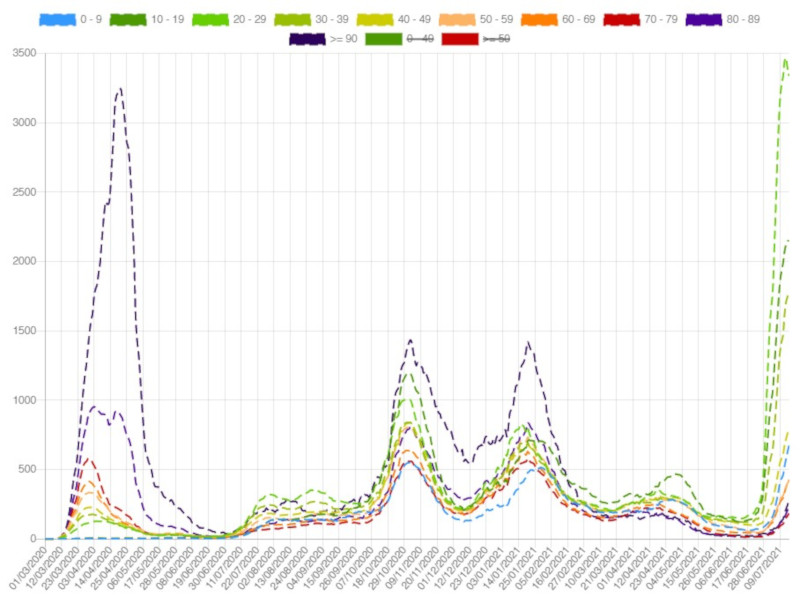Increase in Covid-19 among youths 'stabilized' as hospitalizations quadruple in 3 weeks
Transmission rate continues to fall despite new weekly infections record while authorities expect to see impact of restrictions by 'end of this week'

The sharp increase in Covid-19 cases among the younger people has "stabilized in the past two or three days," public health official Xavier Llaberia said on Monday.
The 20 to 29 age range was the group most affected by the fifth wave of the pandemic – in only two weeks, the incidence rate over 14 days among them skyrocketed from 300 to 3,000 cases per 100,000 inhabitants.
Yet, growth in cases has slowed down over the past few days and on July 14 and 15 – the latest days for which data is available – the trend has shifted, with the incidence rate declining from 3,466 to 3,337.
The remaining age groups are still experiencing increasing infections, albeit more moderate ones.
Indeed, those aged 10 to 19 are the second-most affected group, and while their incidence rate also grew ten-fold in two weeks, the figure has now stabilized at just above 2,100 – something that is also happening in the 30-39 age range at 1,700 after a similar growth in numbers since late June.
Those in their forties (789 on July 19) and children in their first decade of life (673) are next in the rankings, followed by those in their sixties (427) and those in their fifties (419). High vaccination rates among the elderly have led to fewer new cases, with those above 90 at an incidence of 288, those in their eighties at 237, and those in their seventies at 185.
Although figures are more stable, according to the infections information published on the Catalan health department's dadescovid.cat website and reported by Catalan News every day, there were 51,690 new Covid-19 cases diagnosed during week 28 of 2021, which ended on Sunday July 18 – the highest since the pandemic began.
This surpasses what up until now was the weekly record, reported the week prior with 50,102 cases. The exponential growth seen since the end of June, however, is now over.
The second wave peaked at 35,252 – this counts weeks beginning on Monday, and not any seven days in a row.
The third wave saw 30,270 cases in its worst single week in mid-January 2021, with the fourth being much lighter at 12,630 in its worst week, in mid-April, two weeks after Easter.
This is just slightly more than the worst week of the first wave, with 10,667 cases between March 30 and April 5 – yet, the lower availability of tests and the health system's lack of preparation in identifying new cases compared to now also needs to be taken into account for the first wave.
New restrictions include curfew
Authorities recently implemented a set of restrictions to fight this increase in cases, such as reimposing a 10-person limit on gatherings and a curfew in 161 municipalities. Last week, the indoor areas of nightclubs were closed again and local councils were advised to close off beaches and parks.
Llaberia said on Monday that the impact of the latest measures should begin to be noticeable by "the end of this week."
Hospitalizations quadruple but nowhere near previous waves
However, while the fifth wave has surpassed all previous records of cases, this has not been turned into similar amounts of hospitalizations.
Patients in hospital beds are spiking now, with 1,683 as of July 18, which means roughly four times more than June 25 (432), when the figure began to soar.
Yet, this is nowhere near the peak of the third wave, at 3,038, and the top figure in the second, 2,793 – no figures were reported for the first, while the fourth peaked at 1,763.
Likewise, patients in ICUs are on the rise, with the number leaping from 115 to 307 in under three weeks, but some way off the first wave peak (1,529) and that of the third (731). The number of available ICUs across Catalonia are now estimated to be between 900 and 1,000.
The spike in transmissions has led to other indicators also shooting up, such as the outbreak risk, at 1,314 as of July 18 – yet the declining trend already began a few days ago, after the peak at 1,828.
It is considered to be low at 30, moderate at 70, high at 100 and very high at 200. It is calculated using an iEPG index - found by multiplying the average spread of the virus over the past seven days by the cumulative incidence over the past two weeks.
Only one month ago, it stood below the 'high risk' level for the first time in 11 months, but this quickly vanished.
The transmission rate, the number of people each positive case is transmitting the virus to, is also very high, at 1.13, but has also began for over a week. On July 6, it stood at 3.39, meaning that every 100 new positives were transmitting the virus to 339 new people, a rate only surpassed during the first wave.
Vaccinations prompt lower levels of serious patients
Vaccinations have prompted a lower increase of serious patients, with not only significantly less patients in hospitals than in other waves, but a very small amount of fatalities.
While more than 50 people passing away due to Covid-19 in Catalonia every day was normal during the second and third waves (over 100 in the first one), the number of deaths reported has not been over 11 on any day since June 2.
Last week marked a relevant milestone in the rollout: over half of the population have already been fully immunized.
As of July 18, 2021, 4,765,023 residents have been given the first dose of the vaccine, 60.5% of the total population. Out of those, 3,608,896 have also been administered a second dose (46% of the total population). 4,039,064 residents are considered to be fully immunized (51.4%).